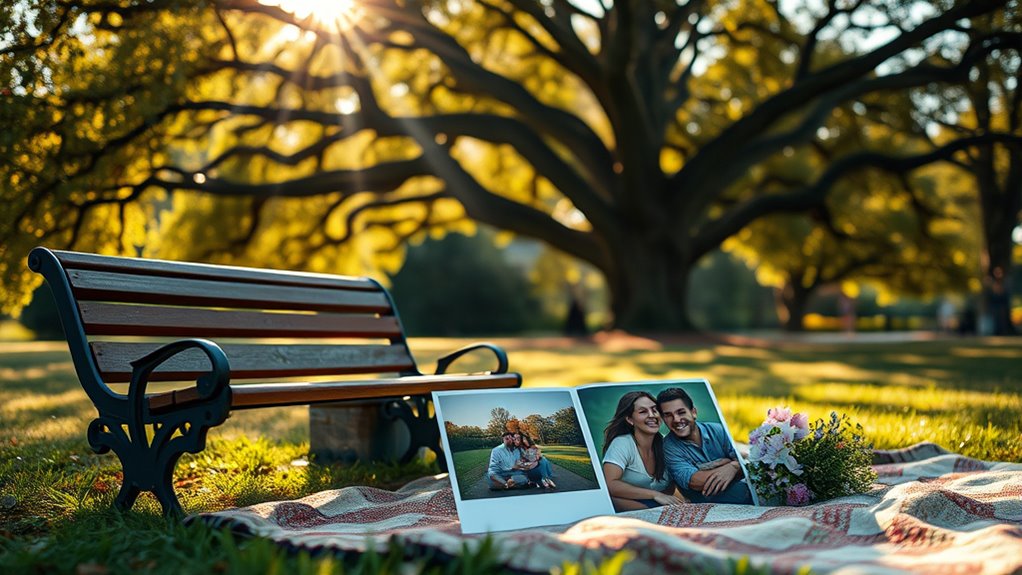To leverage good memories without backsliding, focus on appreciating those moments with gratitude, recognizing them as valuable chapters rather than anchors. Keep a journal to reflect on lessons learned and future goals, and prioritize self-care through activities like exercise or meditation. Gently remind yourself that cherishing memories is natural, but your growth depends on moving forward. By embracing this balance, you’ll strengthen resilience and find peace—keep exploring how to turn nostalgia into a tool for growth.
Key Takeaways
- Practice gratitude by appreciating positive memories as milestones, not anchors, to foster growth without dwelling.
- Use journaling to reframe memories as lessons, supporting emotional resilience and future-focused reflection.
- Engage in self-care activities like exercise or meditation to stay grounded and prevent nostalgia from hindering progress.
- Gently remind yourself that cherishing memories is natural, but prioritize future happiness and personal growth.
- Recognize that consistent effort and patience transform memories into reminders of growth, aiding long-term emotional healing.

To effectively leverage good memories without backsliding, practice gratitude. When you think about the relationship’s positive moments, remind yourself that those memories are part of your story—valuable chapters, but chapters that have closed. Keep a mental or physical journal where you note what you’ve learned from the breakup and what you’re looking forward to. This shift in perspective can help you see those memories as milestones rather than anchors holding you back. Engage in activities that boost your well-being, like exercise, hobbies, or meditation, to reinforce your emotional resilience. These practices foster emotional healing by grounding you in the present and reducing the tendency to dwell on the past. If you find yourself slipping into nostalgia, gently remind yourself that it’s okay to cherish those memories, but not at the expense of your growth. Moving on doesn’t mean forgetting; it means choosing to prioritize your future happiness over past attachments. Additionally, understanding the effects of eye patches can remind you how small, consistent efforts contribute to overall well-being. With time, patience, and intentional effort, you’ll find that your good memories serve as gentle reminders of growth rather than obstacles to your progress. You’re capable of embracing your past without letting it hinder your journey forward.
Frequently Asked Questions
How Long Does Break-Up Nostalgia Typically Last?
Break-up nostalgia can last anywhere from a few weeks to several months, depending on how quickly your memories fade and your emotional resilience grows. During this time, you might find yourself reminiscing, but as you focus on self-care and new experiences, those memories will gradually fade. Building emotional resilience helps you move forward faster, making it easier to let go of lingering feelings and create space for new happiness.
Can Nostalgia Hinder Emotional Recovery After a Breakup?
Oh, nostalgia’s just the charming thief of your emotional recovery, right? It can definitely hinder progress by tugging at your heartstrings with emotional triggers, making you romanticize the past. To cope, focus on new routines and positive memories without backsliding. Recognize nostalgia as a temporary visitor, not a houseguest. That way, you keep moving forward without letting old good times sabotage your healing process.
Are There Healthy Ways to Reminisce About Past Relationships?
You can practice healthy reflection by focusing on positive memories without dwelling on the negatives. When you reminisce, intentionally highlight the good times that brought you joy, but set boundaries to prevent backsliding. Journaling or talking with friends about these moments helps you appreciate the relationship’s highlights. This approach allows you to cherish the past without hindering your emotional healing, fostering balanced nostalgia that supports your growth.
How Do I Differentiate Between Nostalgia and Longing?
When you think about memory vs. longing, you’re noticing the difference between healthy reflection and wishful yearning. If your thoughts bring warmth and gratitude, it’s healthy to reminisce. But if they spark persistent desire or pain, that’s longing. To differentiate, focus on your feelings—healthy reflection nurtures peace, while longing stirs sadness or frustration. Recognize these signs to manage your emotions and honor your healing process.
Does Age Influence the Intensity of Break-Up Nostalgia?
Imagine you’re in a time machine—age definitely influences break-up nostalgia. Older individuals often have greater age-related emotional resilience, helping them manage memories better. Meanwhile, generational breakup patterns shape how intensely you feel nostalgia; younger folks might experience it more vividly because they’re still learning emotional coping. So, yes, age impacts nostalgia, with experience often softening the longing and making it easier to cherish memories without backsliding.
Conclusion
As you walk away from the echoes of your past, remember that nostalgia is like a gentle breeze—beautiful, but fleeting. Cherish the warm glow of good memories without letting them anchor you in yesterday’s storm. Let those moments be like stars guiding your night, not chains holding you in place. Embrace the dawn of your new chapter, where the past’s melody becomes a harmonious part of your future’s song.










